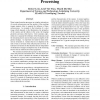Free Online Productivity Tools
i2Speak
i2Symbol
i2OCR
iTex2Img
iWeb2Print
iWeb2Shot
i2Type
iPdf2Split
iPdf2Merge
i2Bopomofo
i2Arabic
i2Style
i2Image
i2PDF
iLatex2Rtf
Sci2ools
IMAGING
2003
2003
Group Theoretical Invariants in Color Image Processing
Many image formation processes are complex interactions of several sub-processes and the analysis of the resulting images requires often to separate the influence of these sub-processes. An example is the formation of a color image which depends on the illumination, the properties of the camera and the objects in the scene, the imaging geometry and many other factors. Color constancy algorithms try to separate the influence of the illumination and the remaining factors and are thus typical examples of the general strategy. An important tool used by these methods are invariants ie. features that do not depend on the state of one (or several) of the sub-processes involved. Illumination invariants are thus features that are independent of illumination changes and depend only on the remaining factors such as material and camera properties. We introduce transformation groups as the descriptors of the sub-processes mentioned above. We then show how they can be used to calculate the number...
Illumination Invariants | Image Processing | IMAGING 2003 | Independent Invariants | Many Image Formation |
| Added | 31 Oct 2010 |
| Updated | 31 Oct 2010 |
| Type | Conference |
| Year | 2003 |
| Where | IMAGING |
| Authors | Reiner Lenz, Linh Viet Tran, Thanh Hai Bui |
Comments (0)

